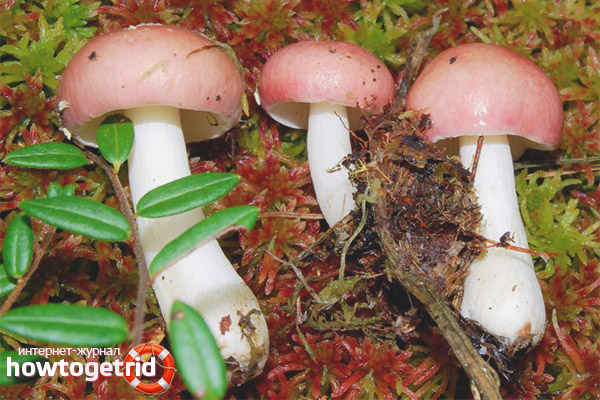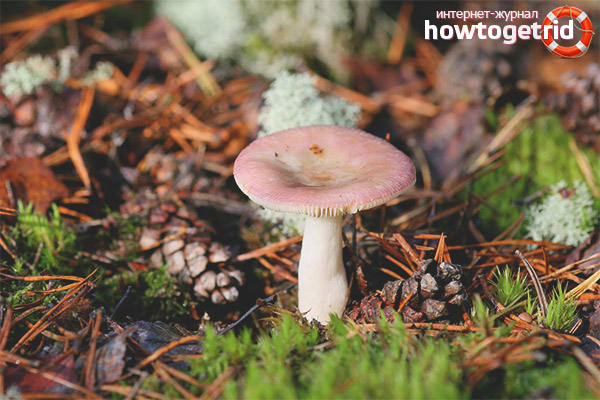The content of the article
Elegant russula grow everywhere - in coniferous forests, and deciduous, and mixed. Bright multi-colored hats - from yellow and red to white and green - can be found anywhere: on grassy meadows, along the slopes of the edges. About a third of the harvest is in these mushrooms. In total, more than 60 species of russula grows in Russian forests; we will talk about russula birch.
Description
Russula birch is not much different from other species. The hat is fleshy, it breaks quite easily, small - up to 5 centimeters in diameter. In young mushrooms, the edges are wavy, with age, small indentations form in the center of the cap. Color varies from red to pinkish-lilac, the middle is slightly yellow. In wet weather it becomes pistachio, spots appear. The peel is easily detached from the cap. The pulp is white, rather fragile, the mushroom smell is weak. The lower part of the cap is lamellar, the plates are white, rare and thin, brittle, slightly adhered to the stem. Egg-shaped spores, white powder.
Legs are empty (especially in mature mushrooms), but dense. Thickness is from 7 to 10 millimeters, length - from 3 to 6 centimeters. After rain, the mushrooms can fall, as the legs get soaked and become very fragile. The upper part is slightly thicker than the lower, covered with wrinkles. It has a yellow or white color.
Places of distribution
How edible
Some types of russula correspond directly to its name - they can be consumed raw without being subjected to heat treatment. This does not apply to Russula birch - the skin covering the hat contains toxins that cause indigestion and pain in the stomach. Therefore, it is better to remove the skin and process the mushroom thermally (fry, cook, stew) for at least 20 minutes, then it will be quite suitable for food and safe.
Healing properties and benefits
Like many mushrooms, birch russula have some healing properties and are successfully used in medicine. First of all, they contribute to the complete cleansing of the gastrointestinal tract and are simply irreplaceable for people suffering from diseases of the digestive system.
- They contain a large number of B vitamins that are involved in all metabolic processes of the body that prevent the formation of anemia and serve as a prophylaxis of nervous diseases.
- The right vitamin C helps the immune system work and helps strengthen blood vessels.
- Useful vitamin E takes part in the formation and development of germ cells, helps to supply oxygen to the tissues of the human body, and nourishes the skin, preventing it from becoming dry. Russula contains many mono- and disaccharides, fatty acids and various dietary fibers. Also, a large amount contains metals, along with useful trace elements - iron, potassium, calcium, phosphorus, sodium. Due to the low calorie content, birch russula are widely used in various diets and contribute to losing weight.
- Among other things, mushrooms contain a lot of lecithin - a substance that interferes with the formation of cholesterol plaques on the walls of blood vessels.
Russula prevent blood clotting and are used as an antithrombotic agent.
Harm and contraindications
Some poisonous mushrooms are very similar in appearance to birch russula, so you should pay maximum attention when collecting and beware of eating them raw.
It is also better to refuse eating russula to people with heart diseases and those who suffer from peptic ulcer of the stomach.
Cooking and cooking
Soups can turn out not very tasty - the bitterish taste contained in the mushrooms will ruin the dish, so it’s better to stew or fry them. And serve with sour cream.
The undoubted advantage of russula is that they are quickly salted and pickled - literally the next day everything is ready! And if you mix with other mushrooms and add onions and other spices - you get an excellent salad.
In general, there are a lot of recipes, so everyone can choose one to their taste.











Submit